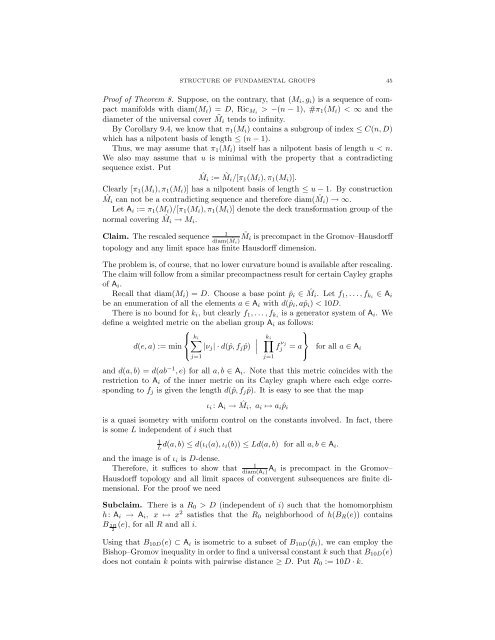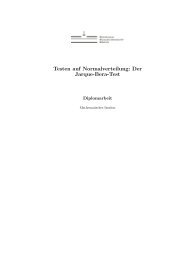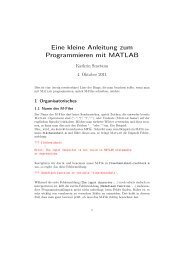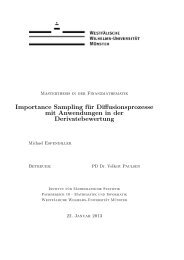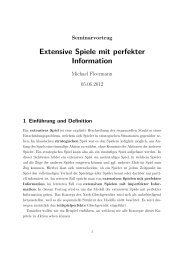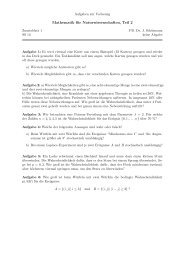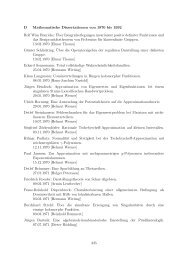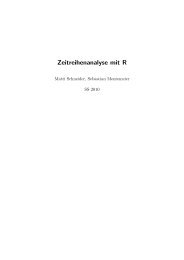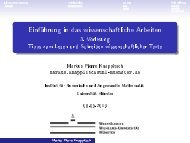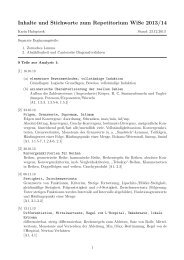Margulis Lemma
Margulis Lemma
Margulis Lemma
You also want an ePaper? Increase the reach of your titles
YUMPU automatically turns print PDFs into web optimized ePapers that Google loves.
STRUCTURE OF FUNDAMENTAL GROUPS 45<br />
Proof of Theorem 8. Suppose, on the contrary, that (M i , g i ) is a sequence of compact<br />
manifolds with diam(M i ) = D, Ric Mi > −(n − 1), #π 1 (M i ) < ∞ and the<br />
diameter of the universal cover ˜M i tends to infinity.<br />
By Corollary 9.4, we know that π 1 (M i ) contains a subgroup of index ≤ C(n, D)<br />
which has a nilpotent basis of length ≤ (n − 1).<br />
Thus, we may assume that π 1 (M i ) itself has a nilpotent basis of length u < n.<br />
We also may assume that u is minimal with the property that a contradicting<br />
sequence exist. Put<br />
ˆM i := ˜M i /[π 1 (M i ), π 1 (M i )].<br />
Clearly [π 1 (M i ), π 1 (M i )] has a nilpotent basis of length ≤ u − 1. By construction<br />
ˆM i can not be a contradicting sequence and therefore diam( ˆM i ) → ∞.<br />
Let A i := π 1 (M i )/[π 1 (M i ), π 1 (M i )] denote the deck transformation group of the<br />
normal covering ˆM i → M i .<br />
1<br />
Claim. The rescaled sequence ˆM<br />
diam( ˆM i is precompact in the Gromov–Hausdorff<br />
i)<br />
topology and any limit space has finite Hausdorff dimension.<br />
The problem is, of course, that no lower curvature bound is available after rescaling.<br />
The claim will follow from a similar precompactness result for certain Cayley graphs<br />
of A i .<br />
Recall that diam(M i ) = D. Choose a base point ˆp i ∈ ˆM i . Let f 1 , . . . , f ki ∈ A i<br />
be an enumeration of all the elements a ∈ A i with d(ˆp i , aˆp i ) < 10D.<br />
There is no bound for k i , but clearly f 1 , . . . , f ki is a generator system of A i . We<br />
define a weighted metric on the abelian group A i as follows:<br />
⎧<br />
⎨∑k i<br />
d(e, a) := min |ν j | · d(ˆp, f j ˆp)<br />
⎩<br />
j=1<br />
∣<br />
∏k i<br />
j=1<br />
f νj<br />
j<br />
⎫<br />
⎬<br />
= a<br />
⎭<br />
for all a ∈ A i<br />
and d(a, b) = d(ab −1 , e) for all a, b ∈ A i . Note that this metric coincides with the<br />
restriction to A i of the inner metric on its Cayley graph where each edge corresponding<br />
to f j is given the length d(ˆp, f j ˆp). It is easy to see that the map<br />
ι i : A i → ˆM i , a i ↦→ a i ˆp i<br />
is a quasi isometry with uniform control on the constants involved. In fact, there<br />
is some L independent of i such that<br />
1<br />
L d(a, b) ≤ d(ι i(a), ι i (b)) ≤ Ld(a, b) for all a, b ∈ A i .<br />
and the image is of ι i is D-dense.<br />
Therefore, it suffices to show that<br />
1<br />
diam(A A i) i is precompact in the Gromov–<br />
Hausdorff topology and all limit spaces of convergent subsequences are finite dimensional.<br />
For the proof we need<br />
Subclaim. There is a R 0 > D (independent of i) such that the homomorphism<br />
h: A i → A i , x ↦→ x 2 satisfies that the R 0 neighborhood of h(B R (e)) contains<br />
(e), for all R and all i.<br />
B 3R<br />
2<br />
Using that B 10D (e) ⊂ A i is isometric to a subset of B 10D (ˆp i ), we can employ the<br />
Bishop–Gromov inequality in order to find a universal constant k such that B 10D (e)<br />
does not contain k points with pairwise distance ≥ D. Put R 0 := 10D · k.


